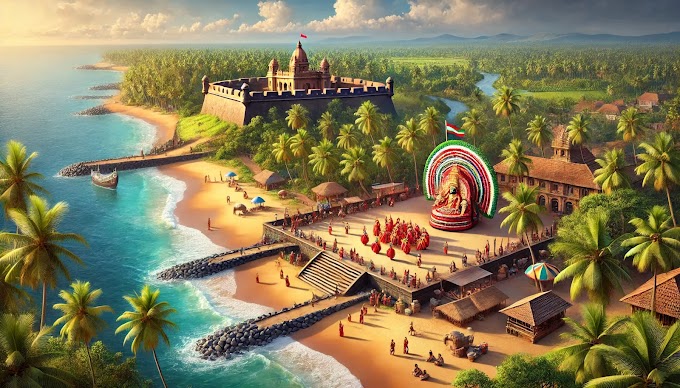 |
| Image Source - Google | Image By Name: ABHIJITJAWANJAL |
Discover the Science, History, and Beauty of Jantar Mantar – Timings, Entry Fees, and Best Time to Visit
Introduction: Jantar Mantar, located in the heart of Delhi, is a remarkable astronomical observatory built by Maharaja Jai Singh II of Jaipur in 1724. This historical site is a fascinating blend of science, architecture, and astronomy, designed to measure time, predict eclipses, and observe celestial bodies. Jantar Mantar is one of five such observatories built by Jai Singh across India and remains an iconic symbol of India's contributions to astronomical advancements. It is a must-visit destination for history buffs, science enthusiasts, and tourists exploring Delhi’s historical landmarks.
History of Jantar Mantar:
The Jantar Mantar in Delhi was commissioned by Maharaja Jai Singh II during the reign of Muhammad Shah. Jai Singh, a scholar of astronomy, mathematics, and architecture, constructed the observatory to refine the astronomical data available during his time. The site was part of a series of observatories built in Jaipur, Ujjain, Mathura, and Varanasi, with the Delhi observatory being one of the largest and most well-preserved.
The name "Jantar Mantar" is derived from Sanskrit, where "Yantra" means instrument, and "Mantra" means calculation. This observatory houses several large instruments or yantras that were used to measure time, track planetary positions, and observe the movements of celestial bodies.
Architectural Significance and Instruments:
Jantar Mantar is renowned for its massive, geometrically designed instruments, which are both functional and architectural marvels. Some of the most important instruments at the site include:
- Samrat Yantra: This is the largest sundial in the observatory, measuring time with remarkable accuracy. It is a giant triangular structure that casts a shadow to indicate the time of day.
- Jayaprakash Yantra: A hemispherical structure with cross wires that helps observers determine the position of celestial objects.
- Misra Yantra: This unique instrument was used to calculate the shortest and longest days of the year and to observe the precise moment of noon in various cities.
- Rama Yantra: Two cylindrical structures that measure the altitude of celestial bodies.
These instruments, built from stone and masonry, were used for precise astronomical measurements centuries ago and continue to fascinate visitors with their accuracy and ingenuity.
Why You Should Visit Jantar Mantar:
A visit to Jantar Mantar offers a deep dive into the scientific advancements of ancient India. The monumental structures are not only impressive to behold but also provide insights into how astronomy and astrology played a vital role in Indian society. Visitors can explore the observatory and learn how the instruments functioned to make precise astronomical calculations long before modern technology.
Jantar Mantar is a popular spot for history lovers, architecture enthusiasts, and those intrigued by the mysteries of the universe. It also provides a peaceful environment for photography and leisure strolls amid its unique architectural wonders.
Best Time to Visit Jantar Mantar:
The best time to visit Jantar Mantar is between October and March when Delhi’s weather is cool and pleasant. This allows visitors to comfortably explore the outdoor structures and enjoy the open spaces. Early mornings or late afternoons are ideal for avoiding crowds and for taking photographs in natural light.
Visiting Timings and Entry Fees:
- Timings: Jantar Mantar is open daily from 6:00 AM to 6:00 PM.
- Entry Fee: ₹15 for Indian citizens, ₹200 for foreign tourists. Entry is free for children.
How to Reach Jantar Mantar:
- Nearest Metro Station: The closest metro station is Janpath Metro Station on the Violet Line, which is just a short walk from Jantar Mantar.
- By Road: Jantar Mantar is centrally located in Connaught Place and is easily accessible via taxis, auto-rickshaws, and buses from all parts of Delhi.
Nearby Attractions:
- India Gate: A war memorial and popular tourist attraction located a short distance from Jantar Mantar.
- Rashtrapati Bhavan: The Presidential residence is nearby and is an architectural marvel.
- Gurudwara Bangla Sahib: A serene Sikh temple, perfect for those seeking peace and spirituality.
Conclusion:
A visit to Jantar Mantar is a unique experience that combines history, science, and architecture. This astronomical wonder offers a glimpse into India’s rich scientific heritage and the innovations of Maharaja Jai Singh II. Whether you're interested in exploring ancient instruments, learning about celestial phenomena, or simply admiring the site's architectural beauty, Jantar Mantar is a must-visit destination in Delhi.
Plan your visit today to witness the astronomical brilliance of Jantar Mantar, a historic observatory that continues to captivate and inspire visitors from around the world.






